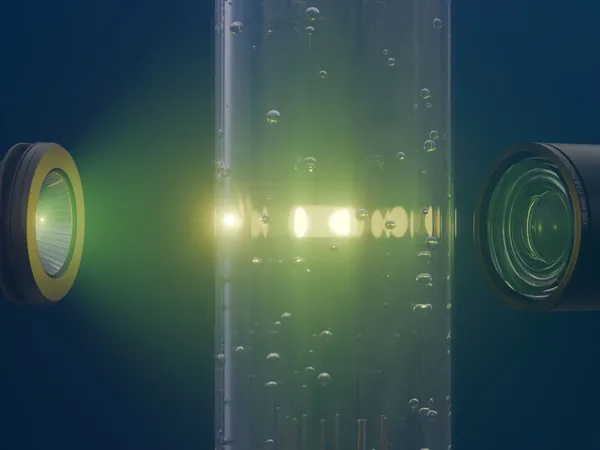
Unlocking the Secrets of Turbulent Bubbles: A Groundbreaking Study
2025-08-20
Author: Nur
Revealing the Unexpected Order in Chaotic Bubbles
Bubble-induced turbulence can be found everywhere—from the fizz in your soda to the turbulent surf crashing on beaches. As bubbles rush through liquids, they create intricate and chaotic fluid movements. Understanding this disorder is essential, not just for enhancing industrial processes but also for refining climate models. One tantalizing question loomed for researchers: Can the renowned turbulence theory, known as 'K41 scaling' by Russian mathematician Andrei Kolmogorov, explain turbulence driven by bubble flows? Previous attempts yielded conflicting results, leaving scientists in a muddle.
Innovative Research Techniques Take Center Stage
Dr. Tian Ma, lead author and physicist at the Institute of Fluid Dynamics at HZDR, aimed to bring clarity to this murky issue. To do this, the research team employed an advanced 3D Lagrangian tracking technique, allowing them to monitor both bubbles and tiny particles in the liquid with remarkable precision. In their experiment, they set up an 11.5 cm wide column of water, precisely introducing gas bubbles from below while capturing the action with four high-speed cameras at a staggering 2500 frames per second.
Cracking the Code of Bubble Swarms
The researchers examined various scenarios, manipulating bubble size and gas volume to replicate realistic flows. Remarkably, bubbles measuring three to five millimeters in diameter exhibited chaotic oscillations during their ascent, leading to vigorous turbulence. In two of these scenarios, particularly with moderate bubble sizes and densities, the turbulence observed aligned closely with Kolmogorov's predictions, marking the first experimental validation of such scaling in an active bubble swarm.
Energy Transfer: How Turbulence Unfolds
"Kolmogorov's theory elegantly explains how energy cascades from larger turbulent eddies to smaller ones, ultimately dissipating through friction," shared co-author Dr. Andrew Bragg from Duke University. The fact that this classic theory aptly describes bubble-driven turbulence was both unexpected and exciting for the team. They also formulated a new equation to quantify energy loss due to viscosity, grounded in two key parameters: bubble size and density. Surprisingly, they found stronger K41 scaling in regions outside the direct wake of the bubbles, where chaotic disturbances dominate.
A Surprising Twist: Nature’s Limitations
One crucial revelation was that for Kolmogorov's 'inertial range'—where its scaling laws are most effective—much larger bubbles would need to be present for this phenomenon to be recognized. However, these larger bubbles would likely disintegrate due to instability, indicating a fundamental limit to applying K41 theory to bubble flows. "Nature, in a sense, inhibits us from achieving perfect Kolmogorov turbulence with bubbles. Yet under ideal circumstances, we now know we can closely approach this state," remarked Dr. Hendrik Hessenkemper, one of the study's co-authors.
Implications for Industry and Future Research
This study not only resolves a longstanding scientific question but also paves the way for improved engineering of bubble-based systems, whether in chemical reactors or wastewater treatment. Furthermore, it enriches our understanding of chaotic phenomena that still align with Kolmogorov's theory, reinforcing its relevance even 80 years later. As Dr. Ma concluded, “The more we comprehend turbulence in bubble flows, the more we can leverage this knowledge in practical applications.” This groundbreaking study opens the door to future exploration into the turbulent behavior of various bubble shapes and conditions.


 Brasil (PT)
Brasil (PT)
 Canada (EN)
Canada (EN)
 Chile (ES)
Chile (ES)
 Česko (CS)
Česko (CS)
 대한민국 (KO)
대한민국 (KO)
 España (ES)
España (ES)
 France (FR)
France (FR)
 Hong Kong (EN)
Hong Kong (EN)
 Italia (IT)
Italia (IT)
 日本 (JA)
日本 (JA)
 Magyarország (HU)
Magyarország (HU)
 Norge (NO)
Norge (NO)
 Polska (PL)
Polska (PL)
 Schweiz (DE)
Schweiz (DE)
 Singapore (EN)
Singapore (EN)
 Sverige (SV)
Sverige (SV)
 Suomi (FI)
Suomi (FI)
 Türkiye (TR)
Türkiye (TR)
 الإمارات العربية المتحدة (AR)
الإمارات العربية المتحدة (AR)